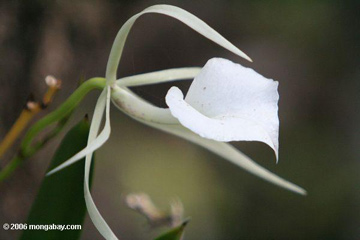Oldest orchid discovered; suggests flower co-existed with dinosaurs
Orchids may have co-existed with dinosaurs
mongabay.com
August 29, 2007
|
|
Orchids are old enough to have co-existed with dinosaurs, report Harvard University scientists.
Writing in the journal Nature, the researchers found the earliest evidence of pollination on the fossil record by examining the remains of an ancient bee trapped in amber. The presence of orchid pollen on its back indicates that orchids arose 76 to 84 million years ago, much longer ago than many scientists had estimated.
“Since the time of Darwin, evolutionary biologists have been fascinated with orchids’ spectacular adaptations for insect pollination,” said lead author Santiago R. Ramírez, a researcher in Harvard’s Museum of Comparative Zoology and Department of Organismic and Evolutionary Biology. “But while orchids are the largest and most diverse plant family on Earth, they have been absent from the fossil record.”
 Lady of the Night Orchid (Brassavola nodosa) in Panama. Photo by Rhett A. Butler |
“Our analysis places orchids far toward the older end of the range that had been postulated, suggesting the family was fairly young at the time of the extinction of the dinosaurs some 65 million years ago,” he continued. “It appears, based on our molecular clock analyses, that they began to flourish shortly after the mass extinction at the so-called ‘K/T boundary’ between the Cretaceous and Tertiary periods, which decimated many of Earth’s species.”
Ramírez and colleagues say that the fossil record for orchids is scant because they “bloom infrequently and are concentrated in tropical areas where heat and humidity prevent fossilization,” according to Harvard. “Their pollen is dispersed only by animals, not wind, and disintegrates upon contact with the acid used to extract pollen from rocks.”
 An amber-preserved stingless bee carrying pollinia of Meliorchis caribea, the first known fossil orchid. Photo courtesy of Harvard University |
The researchers also estimated the age of the major branches of the orchid family. Surprisingly they found that certain groups of modern orchids, including genus Vanilla, evolved very early during the history of the family.
“This result is puzzling and fascinating at the same time because modern species of Vanilla orchids are locally distributed throughout the tropical regions of the world,” says Ramírez. “But we know that tropical continents began to split apart about 100 million years ago, and thus our estimates of 60 to 70 million years for the age of Vanilla suggest that tropical continents were still experiencing significant biotic exchange much after their dramatic split.”
This article is based on a news release from Harvard University.